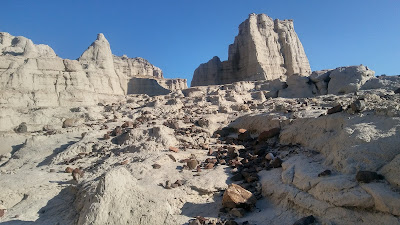Arizona one more time
 |
| Our favorite mountain biking trails in McDowell Regional Park |
It has been a while since our last post since we have been stationary in Arizona and have shared most of the hikes and sights in past posts. This life we are living is constantly changing and after 5 winters in Mesa, Arizona, it is time for something new even though we have loved our time in the desert.
People on motorized scooters riding crazy and homeless people sleeping on the paths along with the increased traffic and people with Alzheimer's driving made the riding our bikes on the paths and streets a little more precarious. As the population of Phoenix continues to grow, so does the air pollution and number of hazardous air quality days. It was time to rethink returning for long stays in the future.
Three years ago, I thought that I was ready to retire but changed my mind wanting to return to work in Mesa at the hospital part time for 3-6 months of the year. I loved the flexibility of being able to return and work part time. There was always great satisfaction in taking care of my patients and the paycheck wasn't so bad either. This time when we returned, we realized that it was time to move on and explore other opportunities after we finish these last few months.
Dia de Los Muertes
Dia de los Muertos honors the dead with festivals and lively celebrations on November 1, a typically Latin American custom that combines Aztec ritual with Catholicism, brought to the region by Spanish conquistadores.
We made a stop at the Mesa Art Center which has its own celebration every year.
The dead would be insulted by mourning or sadness, Dia de los Muertos celebrates the lives of the deceased with food, drink, parties, and activities the dead enjoyed in life (have a party). Dia de los Muertos recognizes death as a natural part of the human experience, a continuum with birth, childhood, and growing up to become a contributing member of the community. On Dia de los Muertos, the dead are also a part of the community, awakened from their eternal sleep to share celebrations with their loved ones.
Heard Museum
There are several ways to avoid breaking the bank and have the opportunity to see some interesting museums. Maricopa County libraries have a cultural pass that can be checked out and used to visit museums or theater shows for free. Phoenix also has free "First Fridays" a trolley will take a person to numerous museums in the downtown. We made a stop at the Heard museum after taking the light rail downtown on a First Friday. We didn't make it much further since there was so much to see at there.
The Heard presents the stories of American Indian people with exhibitions that showcase the traditional and contemporary art. The contemporary art was especially interesting to us. The docent gave us some good in sight as to the artist's intentions.
Scottsdale's Trolley Tour
The second Saturday of each month, Old Scottsdale offers a free Trolley Tour. We made reservations and started the tour at the historic Old Adobe Mission. A private docent talk and tour of this historic structure was given before we boarded the trolley. Built in 1933 by volunteer parishioners, Our Lady of Perpetual Help Old Adobe Mission served as a symbol of community togetherness, pride and hard work. Restoration of the mission began in 2005 and the building is in excellent shape to this day.
The history about the Mexican laborers in the area made me sad. They were brought in when no one else would do the work of picking cotton and given land that no one wanted. Once the town became a success, they were moved on down the road except a few that made successful businesses of their own.
Next we boarded one of Scottsdale’s trolleys to see the downtown. It took us by the Arts District, Southbridge, the Waterfront, and also Hotel Valley Ho. It was a way to learn about Scottsdale’s history, culture, and art, as well as a way to direct us where to find the local restaurants and boutiques. Mostly, encouraging us to patronize the area. It was free...
The trolleys run during the day for free without a tour daily.
After our tour, we headed over to the Rusty Spur Saloon, the oldest of Scottsdale bars, 60 years. It was Scottsdale’s first ever saloon. The building is an officially registered historic landmark that used to be the Farmers’ Bank of Scottsdale. Now the money’s gone and the vault’s filled with liquor.
Over the years, we have had the fun opportunity to explore much of this area.
Things are blooming as we hike again our favorite trails. Now it is time to find some new trails and places.
We look back and are so glad to have met so many good friends but are also very excited about volunteering this next year at Oregon and Texas State Parks.





































































